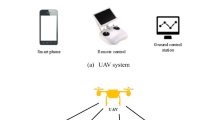Abstract
With the emerging new applications, UAVs are incorporating to our daily lifestyle. The convenience of offering certain services via UAV using its cyber capabilities is very attractive but on the other side poses a great threat of safety and security. With the ever-growing use of commercial WiFi based UAVs, the enduring ability for cybersecurity and safety threats has become a sophisticated problem. UAV networks are susceptible to several common security risks including eavesdropping and jamming attack, denial of service (DoS) or buffer overflow attack by malicious remote attackers. Because of the unique nature of UAV networks, traditional security techniques used by conventional networks is not feasible for UAV communication. The resource constraint nature of such WiFi based UAV network is a key design problem, when implementation of security. Address security issues for UAV domain and propose to examine the practicality of using Identity Based Encryption (IBE) in resource constraint UAV network is our aim in this study. We would like to assess the practicality and performance of IBE in UAV network by measuring energy of the operations for key management and examine the feasibility of the approach and thus present an efficient security framework for resource constrained wireless UAV network.
Access this chapter
Tax calculation will be finalised at checkout
Purchases are for personal use only
Similar content being viewed by others
References
Dini, G., Tiloca, M.: A simulation tool for evaluating attack impact in cyber physical systems. In: Hodicky, J. (ed.) MESAS 2014. LNCS, vol. 8906, pp. 77–94. Springer, Cham (2014). https://doi.org/10.1007/978-3-319-13823-7_8
Rani, C., Modares, H., Sriram, R., Mikulski, D., Lewis, F.L.: Security of unmanned aerial vehicle systems against cyber-physical attacks. J. Defense Model. Simul.: Appl. Methodol. Technol. 13(3), 331–342 (2015)
Snell, B.: McAfee Labs 2017 threats predictions: “Dronejacking” places threats in the sky, November 2016, 2017. https://www.mcafee.com/au/resources/reports/rp-threats-predictions-2017.pdf
FAA Releases 2016 to 2036 Aerospace Forecast (2016). https://www.faa.gov/news/updates/?newsId=85227
Nassi, B., Shabtai, A., Masuoka, R., Elovici, Y.: SoK-security and privacy in the age of drones: threats, challenges, solution mechanisms, and scientific gaps. arXiv preprint arXiv:1903.05155 (2019)
Moormann, D.: DHL parcelcopter research flight campaign 2014 for emergency delivery of medication (2015)
Hooper, M., et al.: Securing commercial WiFi-based UAVs from common security attacks, pp. 1213–1218. IEEE (2016)
Securitymagazine: Privacy and security are biggest concerns about the business use of drones, 2 March 2017. https://www.securitymagazine.com/articles/87868-privacy-and-security-are-biggest-concerns-about-the-business-use-of-drones
Gallagher, S.: Triathlete injured by “hacked” camera drone (2014). https://arstechnica.com/security/2014/04/triathlete-injured-by-hacked-camera-drone/. Accessed June 2017
Hartmann, K., Steup, C.: The vulnerability of UAVs to cyber attacks-an approach to the risk assessment, pp. 1–23. IEEE (2013)
Samland, F., Fruth, J., Hildebrandt, M., Hoppe, T., Dittmann, J.: AR. drone: security threat analysis and exemplary attack to track persons. In: International Society for Optics and Photonics, p. 83010G (2012)
Trujano, F., Chan, B., Beams, G., Rivera, R.: Security analysis of DJI phantom 3 standard. Massachusetts Institute of Technology (2016)
Reddy, S.V., Ramani, K.S., Rijutha, K., Ali, S.M., Reddy, C.P.: Wireless hacking-a WiFi hack by cracking WEP, pp. V1-189–V1-193. IEEE (2010)
Kamkar, S.: SkyJack (2013). Accessed June 2019
Kovar, D.: UAVs, IoT, and Cybersecurity (2016)
Altawy, R., Youssef, A.M.: Security, privacy, and safety aspects of civilian drones: a survey. ACM Trans. Cyber-Phys. Syst. 1(2), 7 (2017)
Parrot Ar.Drone 2.0 Power Edition, Technical Specifications. https://www.parrot.com/global/drones/parrot-ardrone-20-power-edition
PARROT Bebop 2 Power - Pack FPV, Technical Specifications. https://www.parrot.com/global/drones/parrot-bebop-2-power-pack-fpv
Krajník, T., Vonásek, V., Fišer, D., Faigl, J.: AR-drone as a platform for robotic research and education. In: Obdržálek, D., Gottscheber, A. (eds.) EUROBOT 2011. CCIS, vol. 161, pp. 172–186. Springer, Heidelberg (2011). https://doi.org/10.1007/978-3-642-21975-7_16
Valente, J., Cardenas, A.A.: Understanding security threats in consumer drones through the lens of the discovery quadcopter family, pp. 31–36. ACM (2017)
Pleban, J.-S., Band, R., Creutzburg, R.: Hacking and securing the AR. drone 2.0 quadcopter: investigations for improving the security of a toy. In: International Society for Optics and Photonics, p. 90300L (2014)
Giray, S.M.: Anatomy of unmanned aerial vehicle hijacking with signal spoofing, pp. 795–800. IEEE (2013)
Fang, Y., Zhu, X., Zhang, Y.: Securing resource-constrained wireless ad hoc networks. IEEE Wirel. Commun. 16(2), 24–30 (2009)
Doyle, B., Bell, S., Smeaton, A.F., McCusker, K., O’Connor, N.E.: Security considerations and key negotiation techniques for power constrained sensor networks. Comput. J. 49(4), 443–453 (2006)
Shamir, A.: Identity-based cryptosystems and signature schemes. In: Blakley, G.R., Chaum, D. (eds.) CRYPTO 1984. LNCS, vol. 196, pp. 47–53. Springer, Heidelberg (1985). https://doi.org/10.1007/3-540-39568-7_5
Boneh, D., Franklin, M.: Identity-based encryption from the weil pairing. In: Kilian, J. (ed.) CRYPTO 2001. LNCS, vol. 2139, pp. 213–229. Springer, Heidelberg (2001). https://doi.org/10.1007/3-540-44647-8_13
Kodali, R.K., Chougule, S.K.: Hierarchical key agreement protocol for wireless sensor networks. Int. J. Recent Trends Eng. Technol. 9(1), 25 (2013)
Bekmezci, I., Sahingoz, O.K., Temel, Ş.: Flying ad-hoc networks (FANETs): a survey. Ad Hoc Netw. 11(3), 1254–1270 (2013)
Chien, H.-Y., Lin, R.-Y.: Identity-based key agreement protocol for mobile ad-hoc networks using bilinear pairing, pp. 8–pp. IEEE (2006)
Yu, F.R., Tang, H., Mason, P.C., Wang, F.: A hierarchical identity based key management scheme in tactical mobile ad hoc networks. IEEE Trans. Netw. Serv. Manag. 7(4), 258–267 (2010)
Sliwa, B., Ide, C., Wietfeld, C.: An OMNeT++ based framework for mobility-aware routing in mobile robotic networks. arXiv preprint arXiv:1609.05351 (2016)
Author information
Authors and Affiliations
Corresponding author
Editor information
Editors and Affiliations
Rights and permissions
Copyright information
© 2019 Springer Nature Switzerland AG
About this paper
Cite this paper
Haque, M.S., Chowdhury, M.U. (2019). Ad-Hoc Framework for Efficient Network Security for Unmanned Aerial Vehicles (UAV). In: Doss, R., Piramuthu, S., Zhou, W. (eds) Future Network Systems and Security. FNSS 2019. Communications in Computer and Information Science, vol 1113. Springer, Cham. https://doi.org/10.1007/978-3-030-34353-8_2
Download citation
DOI: https://doi.org/10.1007/978-3-030-34353-8_2
Published:
Publisher Name: Springer, Cham
Print ISBN: 978-3-030-34352-1
Online ISBN: 978-3-030-34353-8
eBook Packages: Computer ScienceComputer Science (R0)




